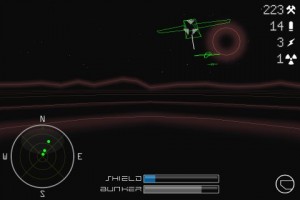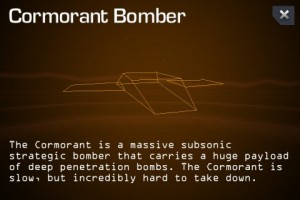 Wireframe Alamo
Wireframe Alamo
It’s never psychologically easy to stare down the barrel of a giant tank gun or watch a bomber plane’s approach, and somehow, it makes little difference that these and myriad other threats are represented by ultra-simple wireframe models in Vector Conflict: The Siege (Out now on sale, $1.99 full price). Seated in the sole machinegun turret guarding a bunker full of those who have survived some apocalypse, the player must gun down waves of machines dispatched to destroy the compound. An endless supply of regular ammo helps, but it’s the player’s strategic use of scarce missiles, EMP charges, and the occasional nuclear warhead that will decide the bunker’s fate.
Despite the fact that the player’s role is tied to an unmoving fixture, Vector Conflict‘s mix of first-person shooting and castle (err, make that “bunker”) defense works decisively in providing an intense and fast-paced experience. It may have started out as a mouse-driven online game but it makes superb use of the iOS, and probably benefited from the transition significantly. The player taps on incoming foes to lock on with the automatically firing regular gun and double-taps to unleash missiles, while a virtual button makes further attack options available. The game’s battlefield spans a full 360 degree radius, so the player must keep a close eye on his or her radar and swipe to rotate the gun turret as the situation develops.
 Vector Conflict throws a satisfying variety of enemy types at the player, gradually upping the ante as he or she succeeds in fending off attacking waves. Opposition ranges from super-fast bomb-strapped kamikaze drones that go down easily to cloaked tanks that demand quick reflexes, creative strategy, and patience if they are to be destroyed. While very accessible thanks to the gradual ramp up in challenge and hand-holding tutorials, Vector Conflict will leave the easily frustrated gamer fuming by the end of the first hour; twitch challenge seekers, however, are especially encouraged to apply for this mission. That’s not to say the game doesn’t build in healthy wiggle room: whoever else is manning the bunker while the player defends it are constantly busy repairing the fortification’s futuristic shielding and converting destroyed machines into resources used for upgrades at the player’s discretion.
Vector Conflict throws a satisfying variety of enemy types at the player, gradually upping the ante as he or she succeeds in fending off attacking waves. Opposition ranges from super-fast bomb-strapped kamikaze drones that go down easily to cloaked tanks that demand quick reflexes, creative strategy, and patience if they are to be destroyed. While very accessible thanks to the gradual ramp up in challenge and hand-holding tutorials, Vector Conflict will leave the easily frustrated gamer fuming by the end of the first hour; twitch challenge seekers, however, are especially encouraged to apply for this mission. That’s not to say the game doesn’t build in healthy wiggle room: whoever else is manning the bunker while the player defends it are constantly busy repairing the fortification’s futuristic shielding and converting destroyed machines into resources used for upgrades at the player’s discretion.
The bunker upgrade process becomes the most interesting aspect of Vector Conflict in that it places great weight on strategic allocation of available resources and the cumulative effects of those decisions over time. Splurging on consumable missiles and bunker repairs might have a lower payoff than upgrading the facility’s radar and the number of bullets the machinegun turret can pump out — and then, later waves become so intense that extremely expensive nuclear warheads might be needed to survive regardless of how good the player’s realtime performance is.
 Vector Conflict offers two modes of play that revolve around accessibility to the upgrade screen: a “Campaign Mode” auto-saves and offers access to upgrade purchases between well-defined waves, whereas “Onslaught Mode” tosses one infinite wave of foes at the player but allows on-the-fly upgrades. Campaign Mode will offer around four to five hours of play on average factoring in from-scratch retries, but the upgrade process leaves enough lingering curiosity on the player’s part to merit a few more playthroughs of its fixed ten waves. Game Center achievements are spread across both modes.
Vector Conflict offers two modes of play that revolve around accessibility to the upgrade screen: a “Campaign Mode” auto-saves and offers access to upgrade purchases between well-defined waves, whereas “Onslaught Mode” tosses one infinite wave of foes at the player but allows on-the-fly upgrades. Campaign Mode will offer around four to five hours of play on average factoring in from-scratch retries, but the upgrade process leaves enough lingering curiosity on the player’s part to merit a few more playthroughs of its fixed ten waves. Game Center achievements are spread across both modes.
Vector Conflict‘s user interface is as spot-on as it needs to be for an intense iOS game, though I never did completely correct my habit of unintentionally shooting missiles — Littlegrey Media could stand to implement some kind of sensitivity setting for the double tap control. Otherwise targeting is forgiving enough that the player can reliably lock on to the tiniest visible dots peeking over the game’s wasteland horizon.
Vector Conflict‘s simple wireframe graphics might remind gamers of ancient Atari titles, and whether or not this is the intended effect enemies zoom by to deliver their payload so fast that their appearance really takes a backseat to their believably insidious AI. The game cancels out external music upon loading but offers a track from the band .We .Got .This .Far that interestingly shifts from spacey futuristic ambiance for run-of-the-mill encounters to heavy guitar riffs during more intense sieges.
iFanzine Verdict: While it obviously appeals more to the challenge-seeking hardcore crowd than to casual gamers, Vector Conflict is addictive, satisfyingly easy to pick up and play, and extremely well implemented on iOS. The game’s aesthetic presentation and length are well suited to its price range, but the quality of the game design on offer here is likely to leave many surprised at what a bargain this truly is.
[xrr rating=4.5/5]


